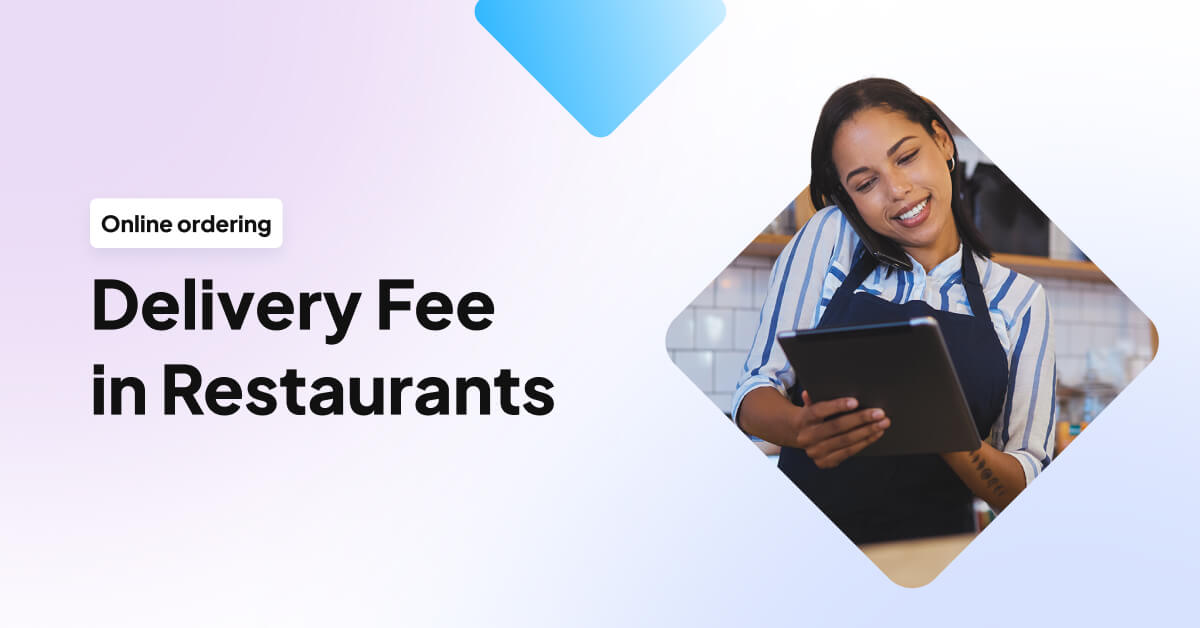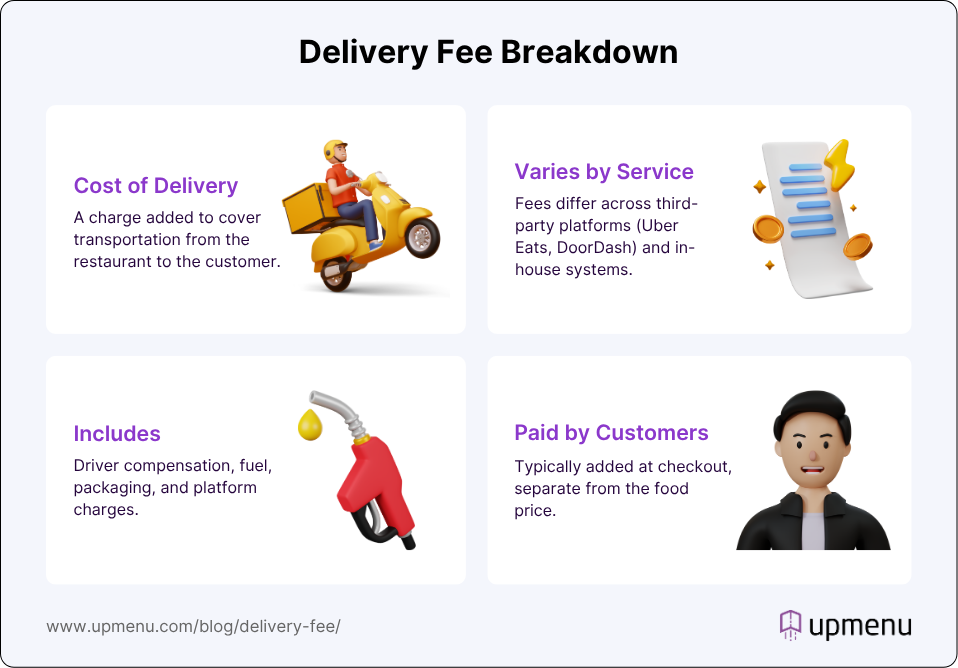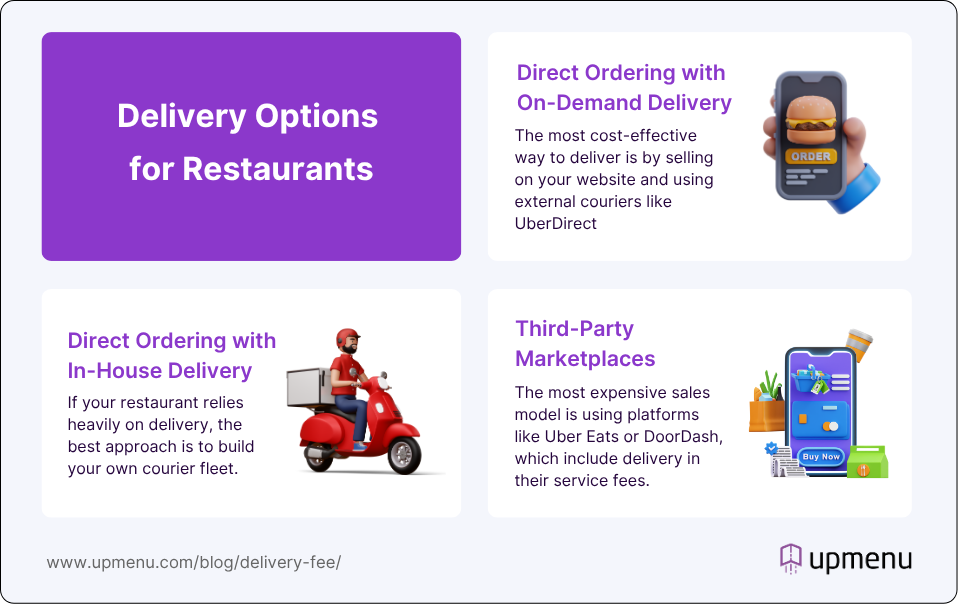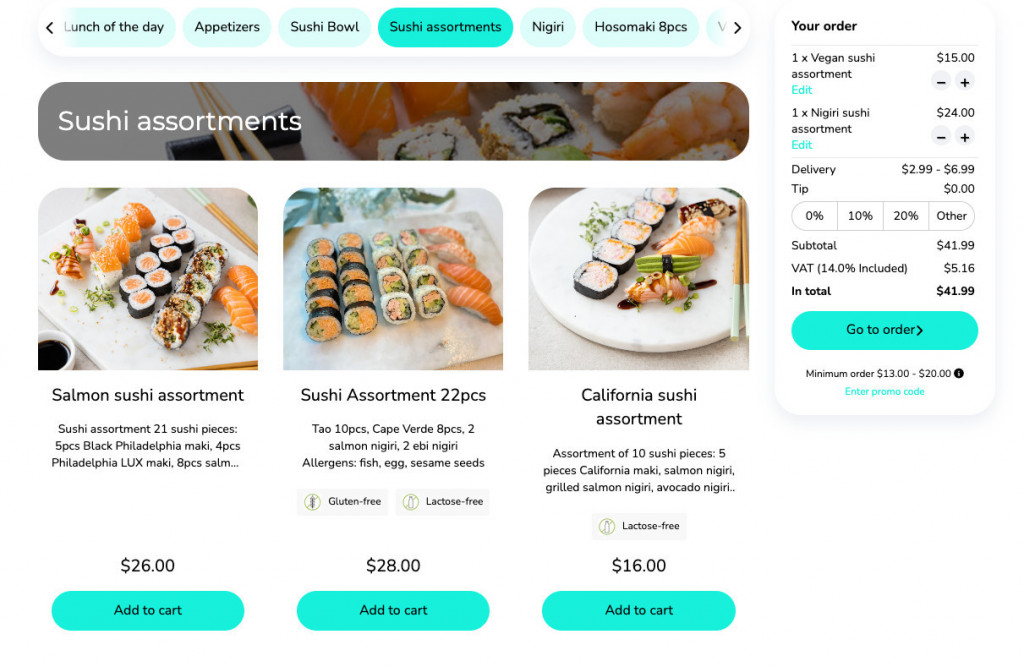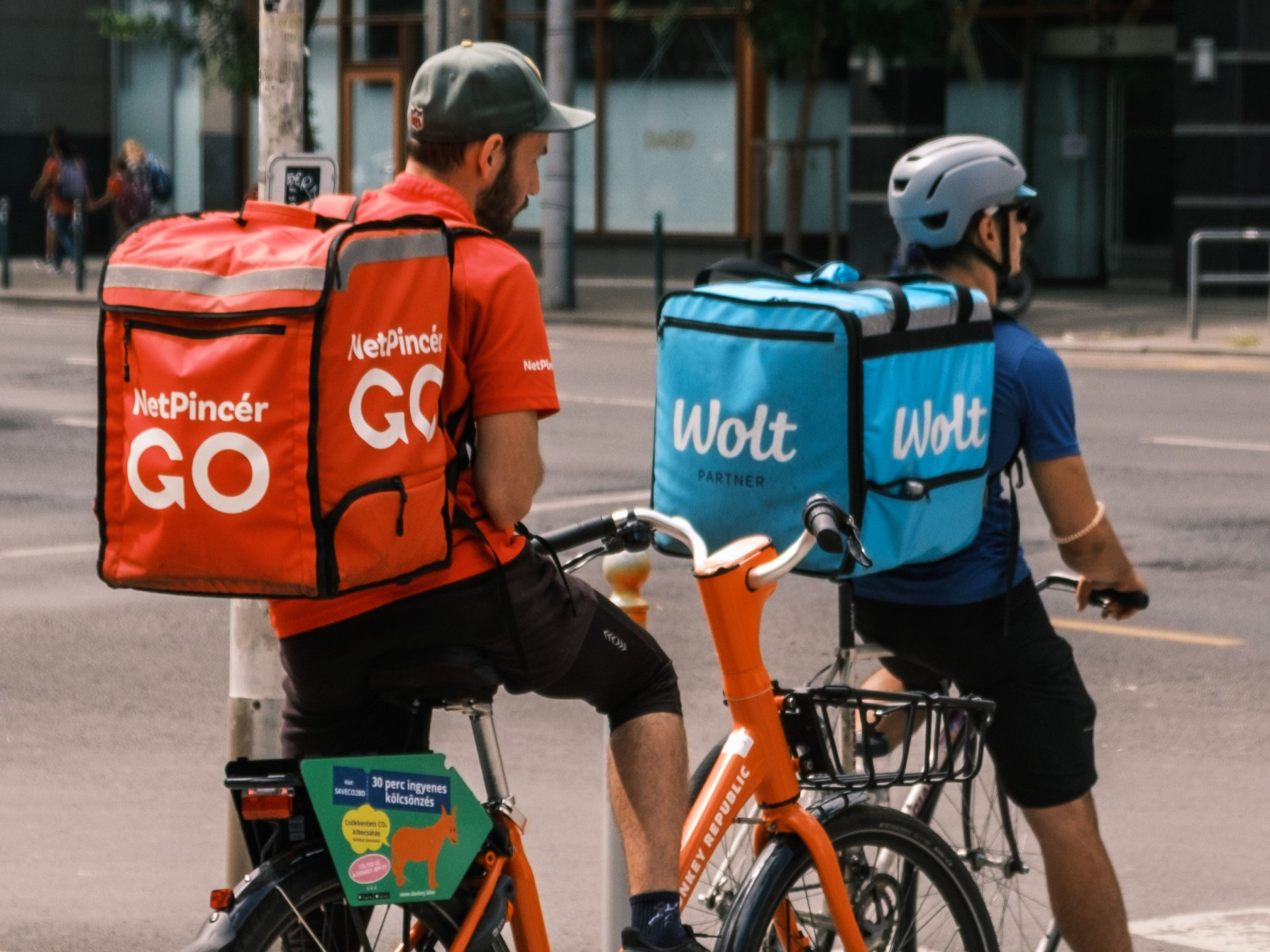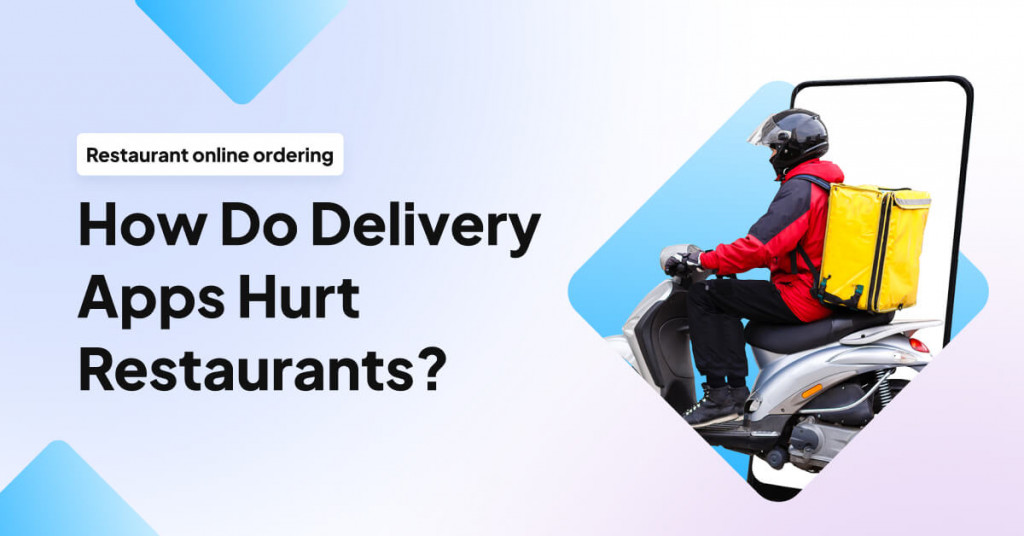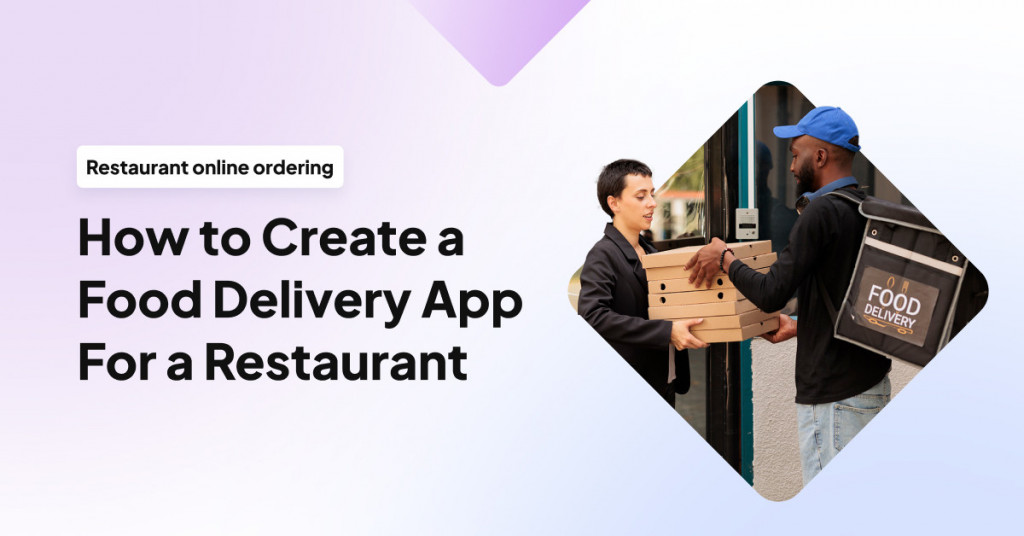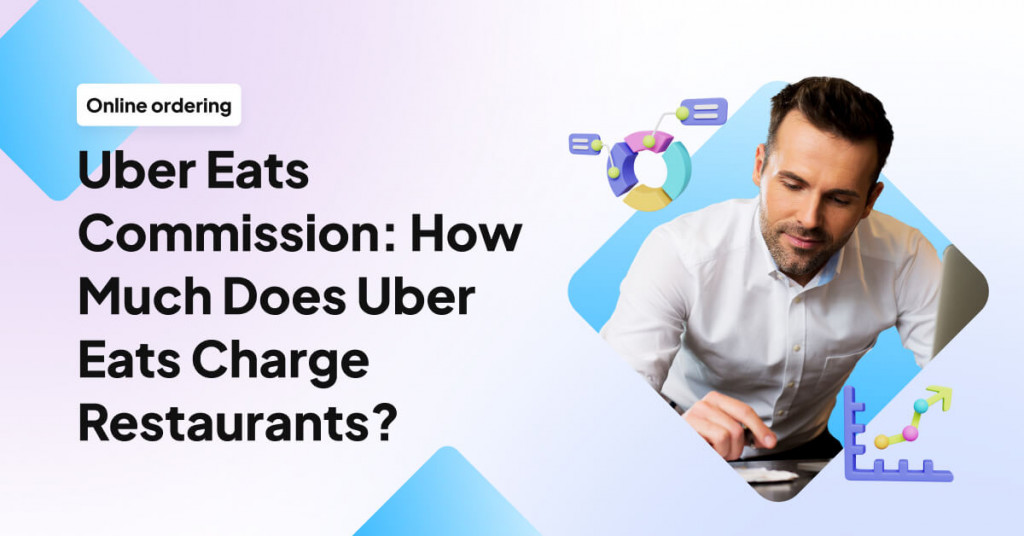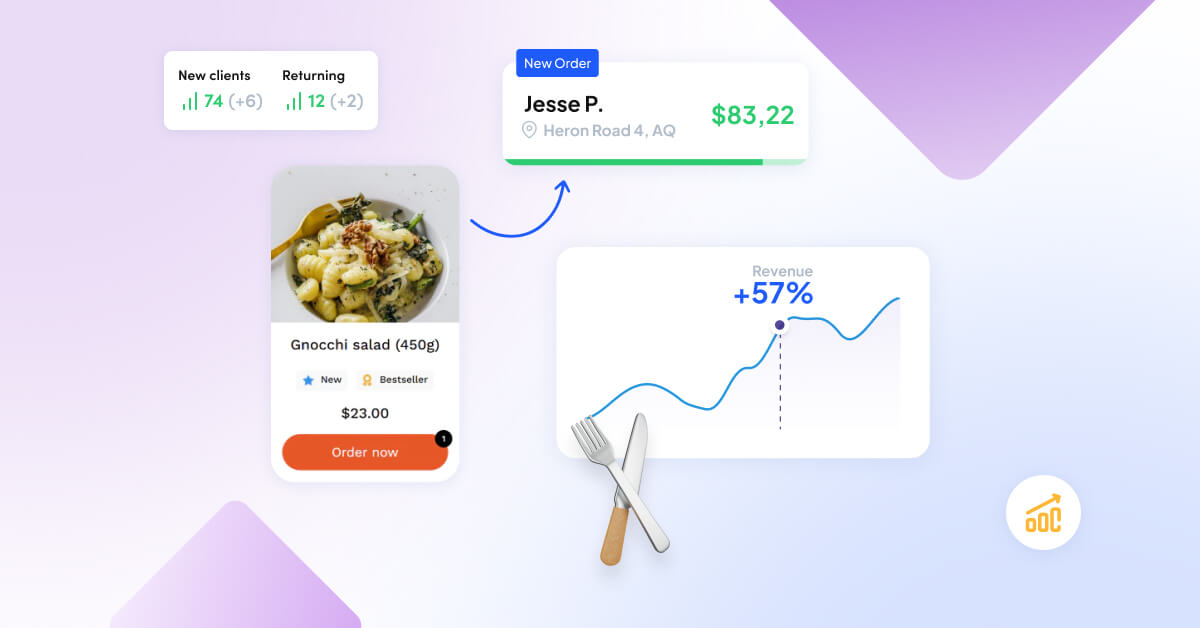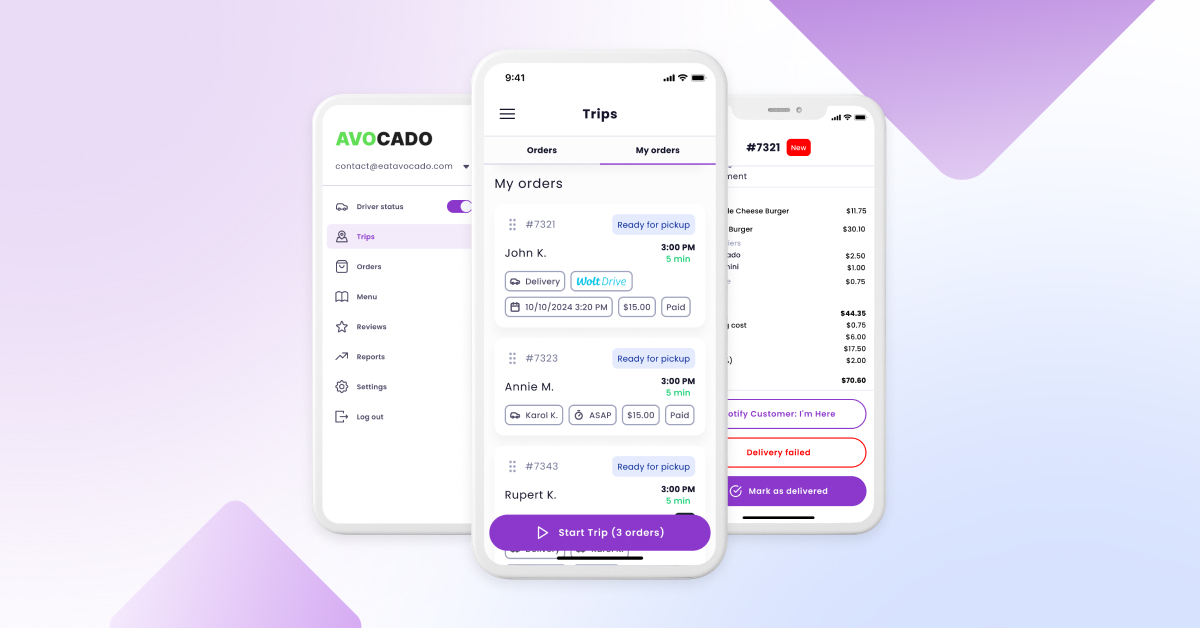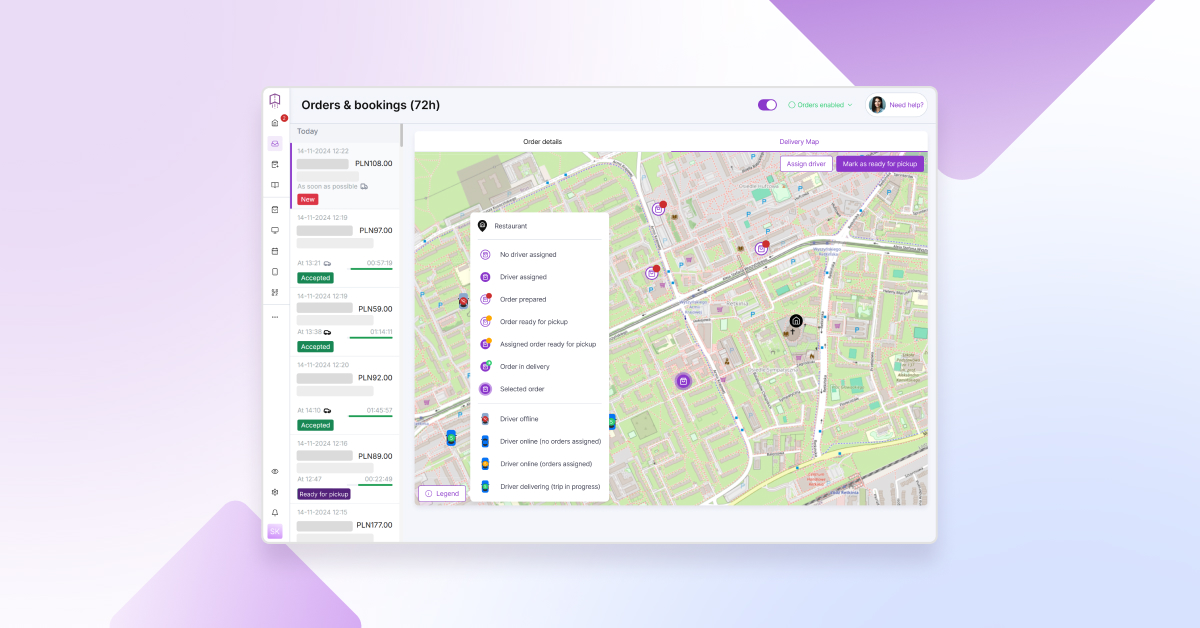The online food delivery market is expected to generate revenues of $1.85 trillion by 2029, and the number of users in the meal delivery market is projected to reach 2.5 billion by the same year.
Delivery fees have become a contentious issue for restaurant owners, particularly with third-party delivery services like Uber Eats and Grubhub capturing a larger share of the market.
A third of consumers would opt to pay an extra fee for faster delivery; however, for restaurant owners, these additional fees can quickly add up.
In this article, I’ll explain what delivery fees are, explore the main delivery service options, discuss third-party delivery app alternatives, and share strategies for reducing your restaurant costs without sacrificing convenience.
Key Takeaways
- 3 Delivery Options for Restaurants: There are three ways to organize restaurant deliveries:
– Direct Ordering with third-party delivery services like Uber Direct or DoorDash Drive
– Direct Ordering with In-House Delivery (own delivery drivers and restaurant delivery software)
– Third-Party Marketplaces like Uber Eats or DoorDash - The cheapest way to organize restaurant deliveries: Direct Ordering with In-House Delivery (Own Delivery Drivers) is the most cost-effective, but it requires significant effort. I recommend it for large restaurants focused on deliveries.
- The most expensive way to organize restaurant deliveries: Direct Ordering with a Third-Party Delivery Service like Uber Direct or DoorDash Drive. I recommend it for restaurants that don’t want to have or manage their own couriers.
- Delivery Fee Structure: Delivery fees can range from 15% to 30% on platforms like Uber Eats and DoorDash, and 5% to 20% on Grubhub. Therefore, evaluate which platform aligns with your business needs and restaurant budget.
- Reduce Reliance on Third-Party Services: Launch a direct ordering with an online ordering system on your restaurant website to cut costs by up to 90%.
- Monitor State-Specific Regulations: Delivery fee laws may vary by state. Most states exempt food deliveries from their regulations; however, there may be exceptions. Therefore, it is essential to stay informed about any changes to local laws to avoid fines.
- Promote Pricing Transparency: Clearly communicating delivery and service fees upfront helps manage expectations and improve satisfaction. A Nielsen Norman Group study found that consumers are 34% more likely to purchase when pricing is clear.
- Increase Your Delivery Sales: If you’re a restaurant owner looking to optimize your delivery services, make sure to check out these five tips on how to increase food delivery sales.
What Is a Delivery Fee?
A delivery fee is a charge that is added to the total cost of an order when a third-party delivery service, such as Uber Eats, delivers the goods on your behalf.
This fee is intended to help the third-party cover the costs associated with delivering your order, such as fuel, vehicle maintenance, and driver compensation.
Fees are a natural way of covering operating costs. That said, many restaurant owners have noticed that, at one point, the commissions charged by food delivery apps to them have become slightly excessive.
More restaurant owners are questioning whether third-party apps are necessary, especially with delivery companies charging over 30% in commissions.
Below, I’ll share some key delivery fee facts every restaurant owner should know.
- Direct ordering: Over 70% of customers prefer to order directly from the restaurant rather than a third-party delivery system like Uber Eats or Grubhub.
- Service fees: Third-party service fees can range from 15% to 30% (and more) of the total order value.
- Delivery fees: Delivery fees charged by restaurants or delivery services typically range from $2 to $5, although some restaurants may charge higher fees for longer distances or during peak hours.
- Customer expectations: Most customers don’t want to wait long for their food, with 31% expecting delivery within 30 minutes. On average, they’re willing to wait no longer than 40 minutes.
- Competition: Global giants like Uber Eats and DoorDash dominate the food delivery market, with DoorDash holding 67% market share and Uber Eats at 23%, outpacing smaller local services.
Delivery Fee vs. Service Fee
The delivery fee covers the cost of getting the food delivered to the customer, including the driver and transportation expenses.
The service fee, applied by platforms like Uber Eats or DoorDash, helps cover operational costs, such as payment processing and customer support. Service fees are often added on top of delivery fees, but serve different purposes—delivery fees cover logistics, while service fees cover platform operations.
In short, the delivery fee covers the logistics of getting food to the customer, while the service fee helps the platform manage its infrastructure and operations. Both fees may appear separately on a customer’s bill but serve distinct purposes.
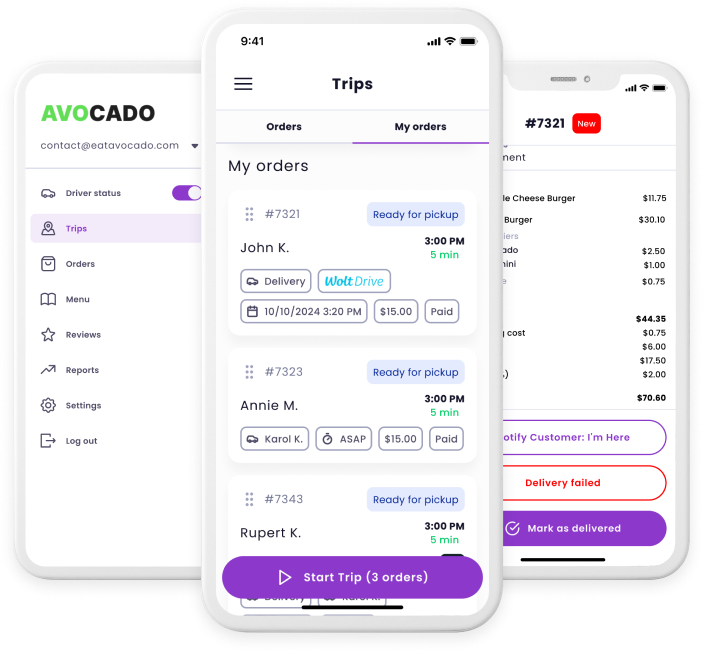
3 Delivery Alternatives for Restaurants: What Delivery Options Do Restaurants Have?
Third-party delivery services, such as Uber Eats and Grubhub, are popular because they enable restaurants to sell food without having to build their own online systems or hire delivery drivers. However, they charge high commissions—often over 30%—which can be detrimental to restaurant profits in the long run.
Direct ordering with in-house delivery, utilizing the restaurant’s delivery drivers, entails managing the entire delivery process internally, encompassing ordering, employee training, and logistics for delivery. While this option gives full control, it requires more resources to implement.
A growing alternative combines the benefits of both: an in-house online ordering system with on-demand delivery. You manage the ordering system, while independent contractors handle delivery for a flat fee. This reduces commission costs and eliminates the need to hire delivery staff.
I’ll outline each option to help you find the best delivery model for your restaurant.
1. Direct Ordering with On-Demand Delivery
An in-house ordering system with on-demand delivery is when you have your own online ordering system integrated with a local delivery service that best suits your needs.
This means that just like the regular in-house ordering system, the restaurant manages the online ordering process.
The difference is that an on-demand delivery service handles the actual delivery of the food for a flat fee per order, and the restaurant doesn’t pay high commission fees to delivery platforms.
That way, you don’t have to worry about training and maintaining a team of delivery drivers.


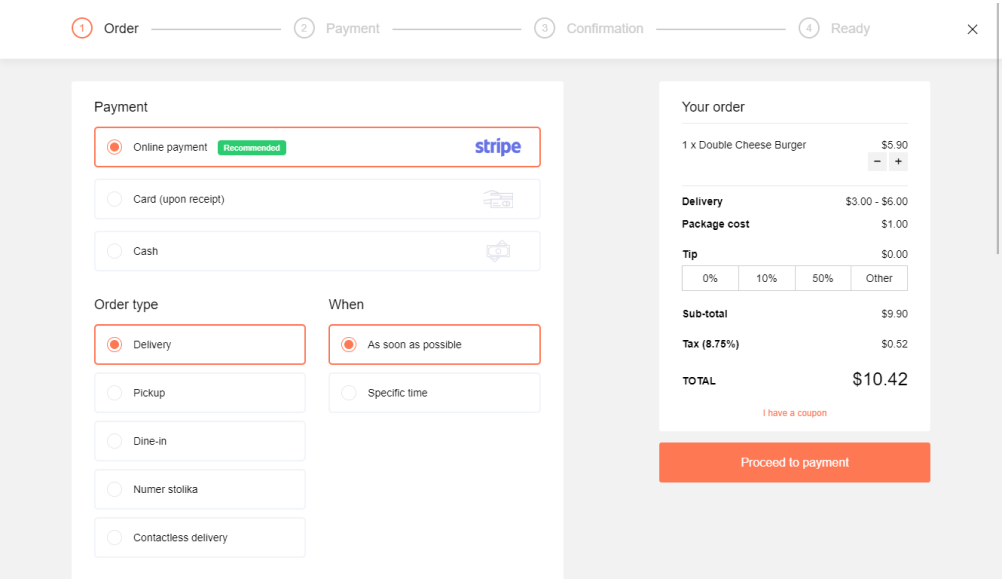
You might be wondering, “Who receives the Delivery Fee in that case?” Restaurants pay the full flat fee to delivery companies and can either pass it on to customers or absorb it by modifying menu prices. In other words, customers either see the delivery fee listed separately on the receipt, or the prices of individual dishes already include the cost.
Pros:
- Control: Restaurants have more control over their brand, menu engineering, and customer experience.
- Customer data: Restaurants have access to valuable customer data, which they can use to personalize marketing messages and improve their overall customer experience.
- Increased revenue: Restaurants can save over 30% in commissions, as they pay a flat fee per order instead of commissions, which they can use to market their brand and increase revenue.
Cons:
- Reliance on Delivery Partners: Although the restaurant manages its food orders, it still relies on an on-demand delivery service, which may lead to inconsistencies or delays outside the restaurant’s control.
- Additional Costs for Delivery: Even with flat fees, delivery can still be expensive, especially if the restaurant operates in an area with high delivery fees or limited service options.
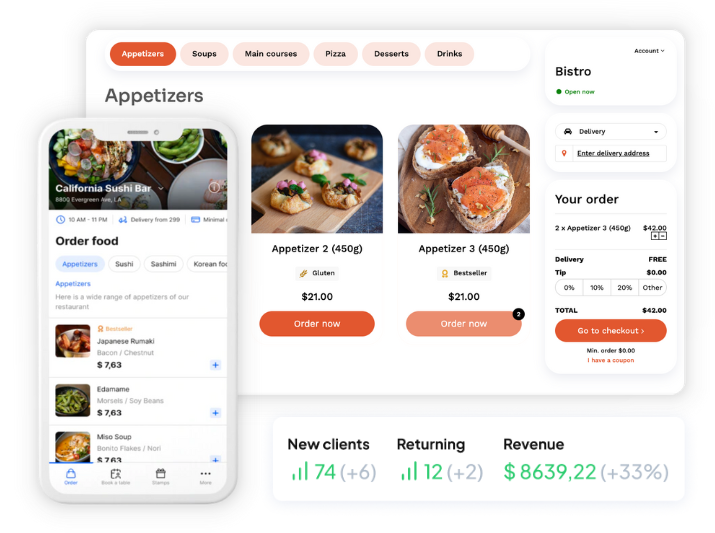
2. Direct Ordering with In-House Delivery (Own Delivery Drivers)
Restaurants that choose direct ordering with in-house delivery manage every aspect of the delivery process themselves. This includes accepting orders, dispatching deliveries, hiring and training drivers, and using restaurant delivery software to optimize routes and track orders.
With this model, restaurants are responsible for hiring drivers, purchasing delivery vehicles, and managing delivery dispatch, including route planning and scheduling. It’s a comprehensive solution that gives restaurants full control over their delivery operations.
Who receives the delivery fee in this delivery model? Restaurant owners or managers calculate the delivery fee and decide how it’s distributed. Generally, it goes to the restaurant. However, if drivers use their own vehicles and cover the fuel costs, part of the fee may be allocated to the driver.
Pros:
- Full Control: Restaurants manage every aspect of delivery, ensuring service quality, punctuality, and customer satisfaction.
- Brand Identity: With in-house delivery, restaurants maintain their brand image throughout the customer experience, from ordering to delivery.
- Cost Savings on Commissions: Restaurants can avoid paying high commission fees to third-party delivery services, resulting in long-term savings.
- Optimized Service: Utilizing restaurant delivery software enables better route planning and order tracking, thereby enhancing delivery efficiency and overall service quality.
- Direct Customer Interaction: Restaurants can build stronger relationships with customers by handling restaurant complaints or issues directly.
Cons:
- Upfront Investment: Restaurants must invest in hiring and training delivery drivers, purchasing vehicles, and implementing delivery management systems.
- Logistical Complexity: Managing deliveries, scheduling, and route planning can be time-consuming and require significant operational resources.
- Limited Exposure: In-house delivery is restricted to the restaurant’s existing customer base, making it more challenging to attract new customers compared to third-party platforms, which have a broader reach.
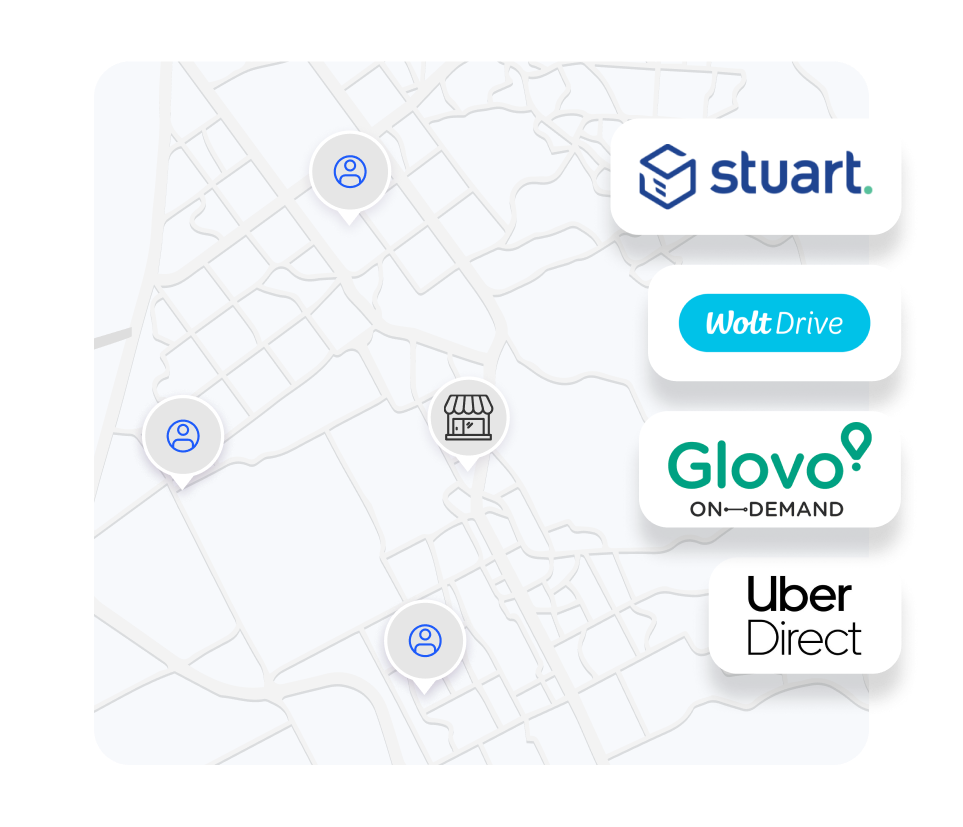
3. Third-Party Marketplaces
Third-party delivery services, such as Uber Eats, Grubhub, and DoorDash, provide a platform for restaurants to receive orders. They handle delivery logistics, customer support, and restaurant payment processing in exchange for commission fees ranging from 15% to 30% of the order value.
Utilizing these services enables restaurants to expand their reach, eliminate upfront delivery costs, and provide customers with convenient delivery options. However, it means less control over the delivery process and potential challenges with maintaining brand identity.
In this delivery model, third-party marketplaces fully retain the delivery fee. Internally, they decide how to compensate their drivers.
Pros:
- Increased exposure: Third-party delivery services help restaurants reach new customers.
- Convenience: These services handle the entire delivery process, making it easier for restaurants without delivery resources.
- No upfront costs: Typically, restaurants only pay commission fees per order, with no initial investment required.
Cons:
- High commission fees: Fees can range from 15% to over 30%, which can be costly as the business grows.
- Lack of control: Restaurants have less control over delivery quality and resolving customer issues.
- Brand dilution: Using third-party platforms may weaken the restaurant’s brand identity and marketing control.
To fully understand the commissions and fees associated with third-party food delivery apps and make an informed decision, check out these articles on Uber Eats commission, DoorDash fees, and Grubhub fees.
Why Is Food Delivery so Expensive? How Much to Charge Your Customers?
High delivery fees impact both customers and restaurateurs. High costs may deter customers from ordering, especially if competitors offer lower rates.
If a restaurant charges significantly higher fees than competitors, it’s likely to see fewer orders than if it were to offer cheaper or free delivery. This is why over 70% of customers prefer ordering directly from the restaurant rather than using third-party services like Uber Eats or Grubhub.
Food delivery costs have risen due to several factors, including higher labor costs for drivers, increased packaging expenses, and inflationary pressures on both food and delivery services.
Additionally, third-party platforms often charge high commissions, which further drive up the cost of delivery. These combined factors contribute to the overall expense of food delivery services.
Below, I’ve created a table showing restaurant delivery fees for 2025.
| Food Delivery App | Delivery Type | Commission/Delivery Fee |
|---|---|---|
| Your Own App | Delivery/Pickup | 0% Commission |
| DoorDash | Delivery | 15% to 30% Commission per delivery order |
| DoorDash | Pickup | 6% Commission per pickup order |
| Uber Eats | Delivery | 15% to 30% Delivery Fee |
| Uber Eats | Self-delivery | 15% Delivery Fee for self-delivery |
| Uber Eats | Pickup | 6% Commission across all partnership plans |
| Grubhub | Delivery | 5% to 20% Marketing Commission (depending on the plan) |
| Grubhub | Delivery-only | 10% Delivery Fee for delivery-only services |
| Grubhub | Supplemental Delivery | 10% Fee for using Grubhub’s fleet while using in-house drivers |
Sources: Grubhub Pricing, DoorDash Pricing, Uber Eats Pricing
The impact of delivery fees on customer behavior depends on the restaurant and market conditions. However, both customers and restaurant owners are increasingly burdened by third-party commissions.
Factors driving high delivery costs include labor, packaging, inflation, and other expenses related to delivery.
To save money, consider investing in your own restaurant mobile app. With a dedicated restaurant app builder, you can avoid high fees and gain more control over delivery without the high cost of custom development.
What Do Restaurant Delivery Fees Cover?
Delivery fees vary depending on whether you use direct ordering with on-demand delivery, direct ordering with in-house delivery (own delivery drivers), or third-party marketplaces. The specific expenses covered by these fees can vary based on the business and the delivery service used.
Below, I’ve outlined what delivery fees typically cover.
- Packaging: Delivery fees help cover the cost of food delivery packaging materials, such as containers, bags, and protective packaging, to ensure food reaches customers in good condition.
- Delivery Driver Compensation: Delivery fees contribute to the payment of delivery drivers, including wages and additional compensation, such as mileage or delivery bonuses.
- Vehicle Maintenance and Fuel: Delivery fees may also help cover the cost of maintaining delivery vehicles, including fuel, repairs, and maintenance.
- Restaurant Insurance: Delivery services may also be required to carry additional insurance coverage for their drivers and vehicles, which can be reflected in the delivery fees.
- Technology and Support: Many delivery services use technology platforms to manage orders, dispatch drivers, and provide customer support. Delivery fees may help cover the cost of developing and maintaining these platforms.
- Administration and Overhead: Delivery fees may also help cover the administrative and overhead costs associated with managing a delivery service or operating a restaurant’s delivery operations.
State-Specific Delivery Fee Regulations: What Restaurants Need to Know
Delivery fee regulations for restaurants vary by state and locality in the U.S. As delivery services grow, understanding these rules is essential for restaurant owners. Some states have retail delivery fees, while others apply taxes on delivery charges.
For example, on July 1, 2024, Minnesota enacted a new retail delivery fee that applies to many types of deliveries, but food and beverage deliveries from foodservice establishments, such as restaurants, were exempt from this fee.
On the other hand, states might apply sales tax to delivery charges, especially if the delivery is considered part of the sale (e.g., California and New York have specific rules around taxing delivery fees for food orders).
It’s crucial to stay updated on local regulations. I recommend consulting with a tax professional or legal advisor who is familiar with local foodservice laws to ensure that you’re following the correct procedures and not missing any exemptions or tax obligations.
How to Minimize Delivery Fees for Your Restaurant
Minimizing delivery fees is crucial for maintaining profitability. By taking control of your delivery process or negotiating better terms with third-party platforms, you can significantly reduce costs while improving your service.
Below, I describe some ways to reduce your delivery order fees.
- Use In-House Drivers: Eliminate third-party services by using your own drivers. This reduces commission fees and gives you control over delivery times. Optimizing routes can further cut fuel and operational costs.
- Negotiate with Delivery Services: Restaurant owners can negotiate with delivery services to lower the commission fees they charge for each order placed through their platform.
- Offer Delivery-Only Specials: Encourage more delivery orders by offering discounts on delivery-only purchases, which helps offset delivery fees.
- Utilize an In-House Ordering System with On-Demand Delivery: Establish your own online ordering system and hire contractors for a flat delivery fee per order, thereby avoiding high third-party fees.
- Offer Pickup Incentives: Reduce delivery costs by offering discounts to customers who pick up their orders instead.
- Implement a Delivery Fee Structure: Set a tiered fee structure based on distance or order size to ensure delivery fees are fair and aligned with the service provided.
Establishing your own online ordering system might seem like a challenge. There are, however, services dedicated to helping you do just that and for a flat fee, freeing you from outrageous long-term contracts and commissions.
In the long run, owning your delivery website and app will keep you in control of your business and help you save a lot of money you’d have to otherwise pay in commissions.
Our clients have saved millions in commission fees by using UpMenu for online ordering. Here are some highlights:
- Sushi Kushi: $1.5 million saved
- Michelangelo 301: $129,474 saved
- Dedicate Healthy Kitchen: $118,397 saved
Discover more case studies and learn how you can achieve these savings!
Customer Perception of Delivery Fees
Customer satisfaction is heavily influenced by how delivery fees are presented. Transparency and clear communication can go a long way in building trust and loyalty.
Research from Simon-Kucher & Partners shows that 70% of U.S. consumers are frustrated by hidden fees and complex pricing structures, which can lead to a negative perception of delivery services.
When customers know exactly what to expect, they are more likely to feel that the fees are fair, especially when they align with the actual costs incurred by the restaurant.
- Be Transparent: Display the delivery fee upfront before checkout, so customers know the total cost.
- Explain the Reasoning: Briefly explain why the fee is necessary, such as covering transportation and packaging costs.
- Offer Fair Pricing: Align the delivery fee with actual costs, taking into account distance, time, and order size.
- Offer Discounts: Waive or reduce delivery fees during restaurant promotions or for loyal customers.
- Add Value Elsewhere: Provide excellent service or exclusive deals to justify the delivery fee.
- Use Tiered Pricing: Charge based on distance or order size, making the fee seem more reasonable.
- Highlight Pickup Options: Offer restaurant discounts for in-store pickups as an alternative to delivery.
- Be Consistent: Ensure delivery fees are fair and consistent to avoid customer frustration.

